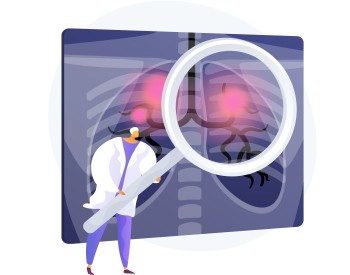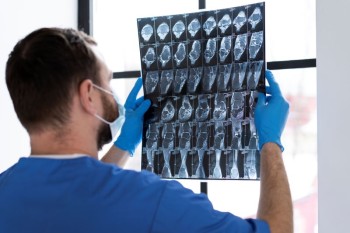
To grasp the depth of CT Brain and Neck Angiography, one must first understand the fundamentals of angiography.
CT Scan Brain and Neck Angiography in India with Cost
Understanding CT Brain
and Neck Angiography
Introduction
In the realm of medical imaging, the CT Brain and Neck Angiography stands as a sophisticated diagnostic tool, providing detailed insights into the intricate vascular structures of the brain and neck. This article aims to unravel the complexities surrounding this advanced imaging technique, delving into its significance, the scanning process, applications, and the transformative impact it holds in neurovascular diagnostics.
Understanding CT Brain and Neck Angiography
To grasp the depth of CT Brain and Neck Angiography, one must first understand the fundamentals of angiography. This imaging technique involves capturing detailed images of blood vessels, highlighting their structure and blood flow. When applied to the brain and neck, it becomes a powerful tool for assessing vascular conditions.
The Procedure Unveiled
Picture a journey into the intricate pathways of the vascular system—the essence of CT Brain and Neck Angiography. Patients lie on a specialized table that moves through a circular machine, capturing cross-sectional images of the brain and neck vessels. The use of contrast agents enhances visibility, allowing healthcare professionals to visualize blood vessels with exceptional clarity.
Valid concerns may arise regarding radiation exposure during CT scans. Nevertheless, technological advancements guarantee meticulous calibration of radiation doses, achieving optimal image quality while prioritizing the safety of patients.
Applications in Neurovascular Diagnostics
The diagnostic capabilities of CT Brain and Neck Angiography extend across a spectrum of neurovascular conditions. From detecting aneurysms, assessing blood vessel abnormalities, to guiding surgical interventions, this imaging modality plays a pivotal role in the diagnosis and treatment planning of neurovascular disorders.
Advantages Over Traditional Angiography
While traditional angiography methods involve invasive procedures, CT Brain and Neck Angiography offer a non-invasive alternative with distinct advantages. By combining detailed imaging with reduced procedural risks, this technique has become a preferred choice for neurovascular assessments.
Ensuring Patient Comfort and Safety
Ensuring patient comfort during the procedure is paramount. While the use of contrast agents may cause a sensation of warmth, radiologic technologists are trained to manage any discomfort effectively. Safety measures, including meticulous contrast administration and monitoring, contribute to a positive patient experience.
Special Considerations for Specific Cases
Individualized approaches are essential, particularly in cases where patients may have allergies or kidney conditions affecting contrast agent use. Radiologists and healthcare providers tailor the procedure to each patient's unique health considerations, ensuring the appropriateness of CT Brain and Neck Angiography.
Interpreting CT Scan Results
Interpreting the results of CT Brain and Neck Angiography requires specialized expertise. Radiologists analyze the images to identify vascular abnormalities, assess blood flow patterns, and provide comprehensive reports to referring physicians. Collaboration between radiologists and neurovascular specialists is crucial for accurate interpretation.
Real-Life Cases and Success Stories
The impact of CT Brain and Neck Angiography on patient outcomes is evident in real-life cases and success stories. Timely and accurate diagnoses facilitated by this imaging modality contribute to effective treatment interventions and improved quality of life for individuals with neurovascular disorders.
The Future of CT Brain and Neck Angiography
As technology advances, the future of CT Brain and Neck Angiography holds promise for further refinements. Ongoing research aims to enhance image resolution, reduce scan times, and explore novel applications in neurovascular diagnostics. The evolving landscape of medical imaging ensures that CT Brain and Neck Angiography remains at the forefront of neurovascular assessments.
Patient Education and Awareness
Educating patients about CT Brain and Neck Angiography is vital for dispelling concerns and fostering informed decision-making. Increased awareness of the procedure, its applications, and potential sensations during the scan contributes to a more confident and engaged patient population.
Costs and Insurance Coverage
Understanding the financial aspects of undergoing CT Brain and Neck Angiography is essential. While the diagnostic value is significant, patients should be aware of potential out-of-pocket expenses. Open communication with healthcare providers assists in navigating financial considerations seamlessly.
Common Misconceptions
Addressing common misconceptions about CT Brain and Neck Angiography is essential for a better-informed public. Concerns about contrast agent safety, radiation exposure, and potential discomfort during the procedure can be clarified through clear communication and patient education.
Conclusion
In conclusion, CT Brain and Neck Angiography emerge as a cornerstone in neurovascular diagnostics, providing unparalleled insights into the vascular structures of the brain and neck. From its detailed procedure to real-life impact and future advancements, this article aimed to offer a comprehensive understanding of the significance of CT Brain and Neck Angiography in modern healthcare.
FAQs - Your Questions Answered
1. What sensations might I experience during a CT Brain and Neck Angiography due to contrast agents?
Certain individuals might feel a temporary warmth or a metallic taste during the administration of the contrast agent. However, these sensations are usually fleeting and diminish rapidly.
2. How long does a CT Brain and Neck Angiography procedure usually take?
The duration of the procedure varies but typically ranges from 20 to 60 minutes, depending on the complexity of the examination and the specific areas being imaged.
3. Are there any specific preparations needed before undergoing CT Brain and Neck Angiography?
For certain instances, patients may need to fast before the procedure. It is advisable for patients to communicate any allergies, existing medical conditions, or medications they are currently taking to their healthcare providers.
4. Can CT Brain and Neck Angiography be performed on pregnant
individuals?
While the use of radiation and contrast agents is generally minimized, pregnant individuals are typically advised to avoid unnecessary medical imaging. Alternative imaging methods may be considered, and consultation with a healthcare provider is recommended.
5. Is CT Brain and Neck Angiography covered by insurance?
Insurance coverage for CT Brain and Neck Angiography depends on the specific insurance plan and the medical necessity of the procedure. Patients are encouraged to check with their insurance providers to understand coverage details.
6. Can I drive myself home after undergoing CT Brain and Neck
Angiography?
In most cases, you should be able to drive yourself home after the procedure. However, if you were administered a sedative or if you feel lightheaded, it's advisable to arrange for someone to drive you.
7. Are there any risks associated with CT Brain and Neck Angiography?
CT Brain and Neck Angiography are generally safe procedures. However, there is a slight risk of an allergic reaction to the contrast agent. It's crucial to inform your healthcare provider about any known allergies before the scan.
8. What information should I provide to the healthcare team before the procedure?
Inform the healthcare team about any pre-existing medical conditions, allergies, medications you are taking, and if there's a possibility of pregnancy. This information ensures a tailored and safe imaging experience.
9. Is there any age limit for undergoing CT Brain and Neck Angiography?
There is typically no specific age limit for CT Brain and Neck Angiography. The decision to undergo the procedure is based on the individual's health condition and the diagnostic requirements determined by the healthcare provider.
10. How soon can I receive the results of the CT Brain and Neck Angiography?
The turnaround time for receiving results may vary. In urgent cases, preliminary findings can be available shortly after the scan. However, a detailed report is provided to the referring physician, who will discuss the results with you in a follow-up appointment.
11. Can individuals with claustrophobia undergo CT Brain and Neck Angiography?
CT machines are generally open, and the procedure is non-invasive, making it suitable for individuals with mild claustrophobia. Radiologic technologists are trained to assist patients in feeling more comfortable during the scan.
12. What happens if I move during the CT Brain and Neck Angiography?
Minimizing movement is crucial for obtaining clear images. If significant movement occurs, it may affect the quality of the images, and the scan might need to be repeated. Radiologic technologists provide clear instructions to help you remain still during the procedure.
(0)
Login to continue



